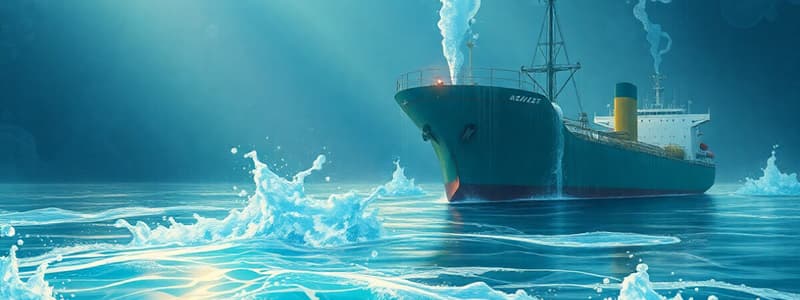Podcast
Questions and Answers
What is the primary purpose of the water wash system described in the text?
What is the primary purpose of the water wash system described in the text?
To remove entrained caustic and/or aluminates from the vapor hydrocarbon stream.
Explain the role of E-350 (Water Wash Heater) in the water wash process and what heats the water?
Explain the role of E-350 (Water Wash Heater) in the water wash process and what heats the water?
E-350 heats the circulating water before it is routed to M-350. The water is heated on the shell side of E-350 by 100 psig steam on the tube side.
Describe the function of P-350A/B (Water Wash Circulation Pumps) and their operational setup.
Describe the function of P-350A/B (Water Wash Circulation Pumps) and their operational setup.
P-350A/B recirculate the water wash stream, with one pump normally in service and the other in standby.
How does E-351 (Water Wash Vapor Cooler) contribute to the water wash process, and what is the purpose of E-351B?
How does E-351 (Water Wash Vapor Cooler) contribute to the water wash process, and what is the purpose of E-351B?
Trace the path of the wastewater after it separates in D-350 (Water Wash Settler), and indicate its final destination as described in the text.
Trace the path of the wastewater after it separates in D-350 (Water Wash Settler), and indicate its final destination as described in the text.
Flashcards
P-350A/B Function
P-350A/B Function
Circulate water wash stream from D-350, used in the water wash process.
E-350 (Water Wash Heater)
E-350 (Water Wash Heater)
A shell and tube exchanger that heats circulating water using 100 psig steam.
E-350 Purpose
E-350 Purpose
Heats the circulating water before it goes to M-350.
T-350 Function
T-350 Function
Signup and view all the flashcards
E-351 Function
E-351 Function
Signup and view all the flashcards
Study Notes
- The skimmed hydrocarbon stream from D-340 and the water from the bottom of T-340 go to M-350 (Water Wash Static Mixer).
- P-350A/B (Water Wash Circulation Pumps) circulate a water wash stream from the bottom of D-350 (Water Wash Settler).
- The water wash stream is heated in the shell side of E-350 (Water Wash Heater) by 100 psig steam on the tube side.
- The heated water wash stream joins the three-phase stream before being routed to and mixing in M-350.
- The resulting three-phase stream from M-350 goes to the bottom of T-350.
- In T-350, the vapor hydrocarbon separates from the liquid phases and rises through the packed bed.
- The vapor hydrocarbon is scrubbed with process water to remove any entrained caustic and/or aluminates and minimize liquid hydrocarbon.
- The scrubbed vapor hydrocarbon is routed to the shell side of E-351 (Water Wash Vapor Cooler) and cooled by cooling water on the tube side.
- Cooling in E-351 condenses the water in the vapor hydrocarbon prior to routing to D-360.
- E-351B (Water Wash Vapor Cooler) is used when E-351 is out of service for cleaning.
- The two liquid phases drop into D-350 and separate.
- Most of the water is recycled by P-350A/B to mix with the hydrocarbon again.
- Wastewater flows to D-353 before being drained to the Oily Water Sewer (OWS).
- Skimmed hydrocarbon is routed to the Debutenizer System.
Equipment Details
- P-350A/B (Water Wash Circulation Pumps) are single-stage centrifugal pumps driven by 25 HP 1750 RPM horizontally-mounted, induction electric motors
- P-350 A/B recirculate the water wash stream.
- Normally, one pump is in service and the other is on standby.
- E-350 (Water Wash Heater) is a shell and tube exchanger that heats circulating water on the shell side using 100 psig steam on the tube side.
- M-350 (Wash Water Static Mixer) has 2 carbon steel fixed elements.
- M-350 mixes the circulating process water with the hydrocarbon stream from D-340.
- T-350 (Water Wash Vapor Scrubber) is 2’D x 23’L.
- T-350 separates the vapor from the two liquid phases.
- The three-phase stream enters the side bottom of T-350.
- Fresh process water enters the side top of the scrubber.
- Overhead vapor exits from the top, and the two liquid phases exit from the bottom, going directly into D-350.
- E-351 (Water Wash Vapor Cooler) is a shell and tube exchanger that cools overhead vapor on the shell side with cooling water on the tube side.
- E-351 condenses water in the vapor before it's routed to D-360.
- E-351B (Water Wash Vapor Cooler) is a hairpin heat exchanger.
- E-351B cools the T-350 overhead vapor stream while E-351 is out of service.
- The process side of E-351B remains blinded and hydrocarbon-free when out of service to prevent contamination and thermal over-pressurization.
- D-350 (Water Wash Settler) is 7’D x 28’L and separates the two liquid phases into a recycled water stream and a skimmed hydrocarbon stream.
- A skim system removes any rag layer developed at the interface.
- The skim system has a skim pan that spans across the drum at 42-44% of the range of the interface float column
- The rag layer is periodically removed to D-353.
- D-353 (Wastewater Degassing Drum) is 3’D x 8’L.
- D-353 receives wastewater, separates the hydrocarbon vapor from the wastewater, and routes the hydrocarbon vapor to the LP Flare before the wastewater goes to the Oily Water Sewer.
- The liquid seal in D-353 must be maintained at all times.
- Failure to maintain the liquid seal will result in hydrocarbon vapor being released to the atmosphere.
Studying That Suits You
Use AI to generate personalized quizzes and flashcards to suit your learning preferences.




